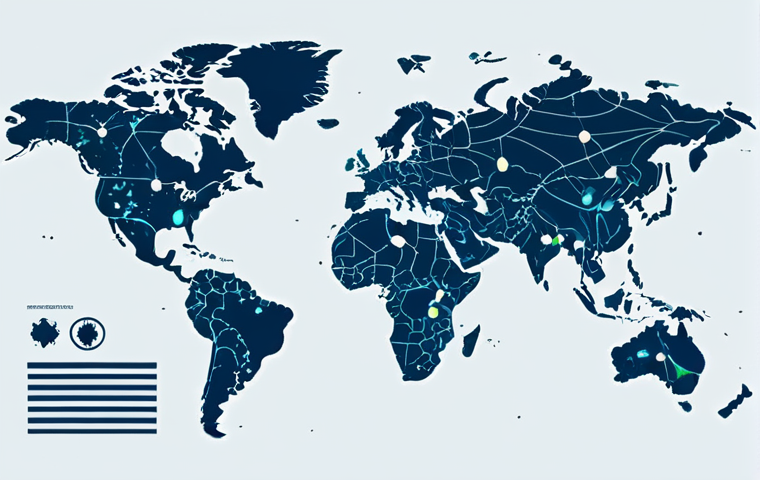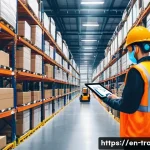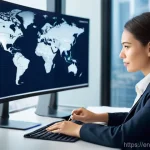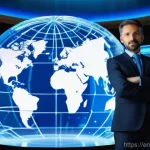So, you’ve got the basics of international trade down, huh? Bills of lading don’t scare you anymore, and you’re not sweating Incoterms like it’s the final exam.
But let’s be honest, truly mastering tradecraft involves more than just memorizing definitions. It’s about understanding the nuances, the unspoken rules, and the ever-evolving landscape shaped by globalization and technology.
From leveraging AI-powered market analysis tools to navigating complex supply chain disruptions (something I learned the hard way during that whole shipping container shortage), taking your knowledge to the next level will future-proof your career.
The trade world is rapidly changing with the rise of digital platforms and sustainable practices. We’ll explore these trends and discuss strategies to adapt and thrive in the years to come.
Let’s delve into it together and solidify your expertise in the following article.
Alright, let’s dive in!
Navigating the Labyrinth of Global Regulations

Global trade isn’t just about moving goods from point A to point B; it’s about understanding the complex web of regulations that govern those movements.
Ignoring these can lead to hefty fines, shipment delays, or even complete import/export bans. From customs compliance to environmental standards, knowing the rules is half the battle.
It’s like trying to navigate a foreign city without a map – you might get somewhere eventually, but you’ll probably take a lot of wrong turns along the way.
When I first started, I remember a shipment of textiles getting held up in customs because we hadn’t properly documented the country of origin. The delay cost us a significant contract!
Decoding Customs Compliance
Customs compliance is more than just filling out forms; it’s about understanding tariff classifications, duty rates, and trade agreements. Misclassifying a product, even unintentionally, can trigger audits and penalties.
1. Staying updated with the Harmonized System (HS) codes is crucial. These codes are used worldwide to classify traded products, but they can change, and keeping track of updates is vital.
2. Leverage technology! There are software solutions that can automate much of the customs compliance process, ensuring accuracy and saving time.
3. Invest in training for your team. Customs regulations are constantly evolving, so ongoing education is essential.
Environmental Regulations and Sustainability
The world is increasingly focused on sustainability, and international trade is no exception. Environmental regulations are becoming stricter, impacting everything from packaging materials to carbon emissions.
1. Understand the environmental regulations of the countries you’re trading with. The EU, for instance, has strict regulations on product packaging and waste management.
2. Embrace sustainable practices. Consider using eco-friendly packaging materials and optimizing your supply chain to reduce your carbon footprint.
3. Get certified. Certifications like ISO 14001 can demonstrate your commitment to environmental sustainability and enhance your reputation.
Mastering the Art of Cross-Cultural Communication
International trade is, at its heart, a human endeavor. It’s about building relationships, negotiating deals, and collaborating with people from diverse cultural backgrounds.
However, cultural differences can sometimes create misunderstandings or friction, so mastering cross-cultural communication is essential. I’ve seen deals fall apart simply because of cultural faux pas, like using the wrong tone during negotiations or misunderstanding non-verbal cues.
Understanding Cultural Nuances
Every culture has its own unique communication styles, values, and etiquette. What’s considered polite in one culture might be offensive in another. 1.
Research the cultures of your business partners. Understand their communication styles, business etiquette, and values. 2.
Pay attention to non-verbal cues. Body language, facial expressions, and tone of voice can all convey meaning, but they can also be easily misinterpreted.
3. Be patient and flexible. Don’t expect everyone to communicate the same way you do.
Be willing to adapt your communication style to suit the situation.
Effective Communication Strategies
Effective communication goes beyond just speaking the same language; it’s about understanding each other’s perspectives and building trust. 1. Use clear and simple language.
Avoid jargon, slang, and idioms that might not be understood by non-native speakers. 2. Listen actively.
Pay attention to what the other person is saying, and ask clarifying questions to ensure you understand them correctly. 3. Build rapport.
Take the time to get to know your business partners on a personal level. Show genuine interest in their culture and their business.
Leveraging Technology for Competitive Advantage
In today’s digital age, technology is transforming international trade in profound ways. From streamlining supply chains to improving communication, technology can give businesses a significant competitive advantage.
But it’s not just about adopting the latest gadgets; it’s about strategically leveraging technology to solve specific problems and improve efficiency.
Supply Chain Management Software
Supply chain management (SCM) software can help businesses track shipments, manage inventory, and optimize logistics. 1. Choose the right SCM software.
Look for a solution that meets your specific needs and integrates with your existing systems. 2. Use SCM software to improve visibility.
Track shipments in real-time, identify bottlenecks, and proactively address potential disruptions. 3. Optimize your supply chain.
Use SCM software to analyze data, identify inefficiencies, and optimize your logistics.
Data Analytics and Market Research Tools
Data analytics tools can help businesses identify market trends, assess risks, and make informed decisions. 1. Use data analytics to identify new market opportunities.
Analyze trade data, market research reports, and consumer trends to identify promising markets. 2. Assess risks.
Use data analytics to identify potential risks, such as political instability, economic downturns, and supply chain disruptions. 3. Make informed decisions.
Use data analytics to evaluate different scenarios, weigh the pros and cons, and make the best possible decisions.
Mitigating Risks in International Trade
International trade involves a variety of risks, including political risks, currency risks, and credit risks. Managing these risks is essential for protecting your business and ensuring profitability.
I learned this the hard way when a major currency devaluation wiped out our profits on a large export deal. Now, we have a comprehensive risk management strategy in place.
Currency Risk Management
Currency fluctuations can significantly impact your profits. A sudden devaluation of a foreign currency can make your exports more expensive and your imports cheaper.
1. Use hedging strategies. Hedge your currency risk by using forward contracts, options, or currency swaps.
2. Invoice in your own currency. If possible, invoice your customers in your own currency to avoid currency risk altogether.
3. Monitor currency markets. Keep a close eye on currency markets and be prepared to adjust your pricing strategy accordingly.
Political Risk Insurance

Political instability, trade wars, and government regulations can all disrupt international trade. Political risk insurance can protect your business against these risks.
1. Assess your political risk exposure. Identify the countries where you’re most exposed to political risk.
2. Consider political risk insurance. Political risk insurance can protect your business against losses caused by political violence, expropriation, and currency inconvertibility.
3. Diversify your markets. Don’t rely too heavily on any one market.
Diversify your markets to reduce your overall political risk exposure.
Building a Robust International Network
Success in international trade depends not only on what you know but also on who you know. Building a strong network of contacts can provide you with valuable insights, opportunities, and support.
Networking isn’t just about collecting business cards; it’s about building genuine relationships with people who can help you succeed. I’ve found that some of my most valuable business connections have come from attending industry events and joining trade associations.
Attending Trade Shows and Conferences
Trade shows and conferences are great places to meet potential customers, suppliers, and partners. 1. Research trade shows and conferences.
Identify the events that are most relevant to your industry and your business goals. 2. Prepare your pitch.
Be ready to present your business and your products to potential customers and partners. 3. Follow up.
Follow up with the people you meet at trade shows and conferences to build relationships and explore potential opportunities.
Joining Trade Associations and Chambers of Commerce
Trade associations and chambers of commerce can provide you with access to industry information, networking opportunities, and advocacy. 1. Identify relevant trade associations and chambers of commerce.
Look for organizations that are focused on your industry and your target markets. 2. Participate in events and activities.
Attend meetings, workshops, and networking events to meet other members and learn about industry trends. 3. Get involved.
Volunteer to serve on committees or boards to increase your visibility and build your network.
Understanding and Utilizing Free Trade Agreements (FTAs)
Free Trade Agreements (FTAs) are agreements between two or more countries to reduce or eliminate trade barriers such as tariffs and quotas. Understanding and utilizing FTAs can provide significant advantages to businesses engaged in international trade, such as reduced costs and access to new markets.
I’ve personally witnessed how leveraging FTAs can transform a business’s bottom line.
Identifying Relevant FTAs
The first step is to identify FTAs that are relevant to your business and the countries you trade with. 1. Research existing FTAs.
Many countries have multiple FTAs with different nations. Determine which ones apply to your business based on your trading partners. 2.
Understand the scope of the FTAs. FTAs vary in what they cover, from specific industries to types of goods and services. Make sure the FTA includes your products or services.
3. Check for updates. FTAs are often updated or renegotiated.
Stay informed about any changes that might affect your trade activities.
Maximizing Benefits from FTAs
Once you’ve identified relevant FTAs, it’s important to understand how to maximize their benefits. Here is an example table on FTA:
| FTA Benefit | Description | How to Utilize |
|---|---|---|
| Reduced Tariffs | Lower import and export duties, reducing costs. | Ensure your goods qualify under the FTA’s rules of origin. |
| Simplified Customs Procedures | Streamlined processes for imports and exports. | Understand documentation requirements and use pre-clearance programs if available. |
| Market Access | Increased access to new markets and customers. | Research market demands and adapt products to meet local standards. |
| Protection of Intellectual Property | Stronger protection of your patents, trademarks, and copyrights. | Register your IP in the FTA countries and monitor for infringements. |
1. Certificates of origin. Correctly document the origin of your goods to take advantage of preferential tariff rates.
2. Customs compliance. Ensure your business complies with the FTA’s customs regulations to avoid penalties and delays.
3. Market research. Use FTAs to expand your market reach by targeting countries where you gain a competitive advantage.
Navigating the world of international trade can feel like walking a tightrope, but with the right strategies and knowledge, you can not only stay balanced but also thrive.
From regulatory compliance and cultural understanding to leveraging technology and managing risks, each aspect plays a vital role in your global success.
Remember that time I almost missed a deadline because I didn’t factor in the time difference? Classic rookie mistake! Learning from those experiences and staying adaptable is what sets successful traders apart.
Wrapping Up
As we conclude this journey through the intricacies of international trade, remember that continuous learning and adaptation are your greatest assets. Embrace the challenges, leverage the opportunities, and never underestimate the power of a well-forged relationship. Here’s to your global success!
Useful Tips to Know
1. Subscribe to industry-specific newsletters to stay updated on regulatory changes and market trends. Many trade associations offer free or low-cost newsletters packed with valuable information.
2. Utilize online translation tools, but always double-check with a native speaker to ensure accuracy. A misinterpreted word can lead to significant misunderstandings.
3. Attend webinars and online courses on international trade topics. These are often a cost-effective way to gain expertise without traveling.
4. Join online forums and communities related to international trade. Engage with other professionals, ask questions, and share your experiences.
5. Consider hiring a consultant or advisor with expertise in international trade law or customs compliance. Their guidance can save you time and money in the long run.
Key Takeaways
To summarize, remember the importance of:
Thorough understanding of global regulations to avoid costly mistakes.
Cultivating cross-cultural communication skills for successful negotiations and partnerships.
Strategic use of technology to streamline processes and gain a competitive edge.
Proactive risk management to protect your business from currency fluctuations and political instability.
Building a robust international network for valuable insights and opportunities.
Leveraging Free Trade Agreements (FTAs) to reduce costs and expand market access.
Frequently Asked Questions (FAQ) 📖
Q: How can
A: I tools actually help me in international trade beyond just basic data crunching? A1: Okay, so forget about just spreadsheets and basic reports. I’m talking about using AI to predict market trends before they hit, optimize your shipping routes in real-time (remember that port congestion fiasco last year?
AI could’ve softened that blow!), and even personalize your customer outreach based on cultural nuances. Think about it: an AI can analyze social media sentiment in a target market to gauge demand for your product and tweak your marketing campaign accordingly.
It’s like having a team of analysts working 24/7, giving you an edge I only dreamed of when I started out. The key is understanding which tools are legit and not just hyped-up vaporware – that’s where doing your homework (and maybe attending a few industry webinars) pays off.
Q: Sustainability in trade sounds like a buzzword. How is it really impacting the bottom line, and what concrete steps can I take to make my operations greener?
A: Listen, I used to think sustainability was just good PR, but trust me, it’s way more than that. Consumers, especially younger generations, are actively choosing brands that prioritize ethical sourcing and environmental responsibility.
So, ignoring it means leaving money on the table. Think about it: you can reduce your carbon footprint by optimizing your shipping containers or sourcing materials locally (even if it costs a tiny bit more upfront).
My old company switched to eco-friendly packaging, and sales actually jumped! The trick is to be transparent about your efforts and get certified by a reputable organization – it builds trust and protects you from accusations of “greenwashing”.
Q: With all the global uncertainties and political tensions, how do I even begin to future-proof my international trade career?
A: That’s the million-dollar question, right? Honestly, there’s no magic bullet, but adaptability is your best friend. First, specialize in a niche area that’s likely to remain in demand, like cybersecurity for trade or international trade law.
Second, constantly upskill – take online courses, attend industry conferences, and network with experts. I actually learned Python just to automate some of my reporting tasks!
Finally, cultivate a global mindset. Understand different cultures, learn a second (or third!) language, and be prepared to navigate complex geopolitical landscapes.
It’s a constant learning process, but the more you invest in yourself, the more resilient you’ll be to whatever the future throws your way.
📚 References
Wikipedia Encyclopedia
구글 검색 결과
구글 검색 결과
구글 검색 결과
구글 검색 결과






